All-in-One Printer Shootout
The new Kodak inkjet takes on Canon, Epson, and HP. Several hundred prints and many lab tests later, the best all in one printer is...
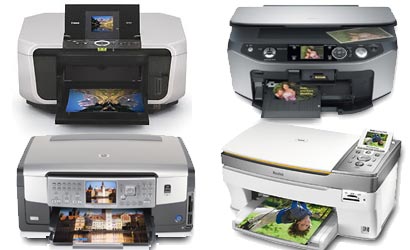
We may earn revenue from the products available on this page and participate in affiliate programs. Learn more ›
When there’s no room in the budget or space in the office for a separate photo printer, scanner, fax machine, or copier, an all-in-one (AIO) device might be your best choice. But do serious photographers give up image quality or performance by going this route? Or has premium printing and scanning technology finally trickled down into these jack-of-all-trades? That’s what we set out to discover in our first AIO shootout.
We chose four AIOs representing the best values in this class — the Epson Stylus Photo RX580 ($150 street), Canon’s Pixma MP810 ($275 street), Kodak’s EasyShare 5300 ($199 street) and HP’s Photosmart C7180 ($379 street). All four can produce 8.5×11-inch borderless prints and scan similar sized photos or documents, with built-in card readers for direct printing from memory cards, and LCD color monitors for viewing menus. The higher priced Canon and HP models include a film holder and backlights for scanning negative and slides. In addition, the HP features a larger 3.6-inch LCD monitor, 8.5×12-inch scanning bed, Fax modem, built-in wireless Bluetooth transfer and 802.11G (WiFi) networking, and a wired Ethernet connection.
Kodak claims its new 5300 (and other inkjet models in its AIO family) can produce prints at a cost savings of up to 50% over its competitors, or 4×6 prints at only 10 cents each (about the lowest price you can get at discount online photoprocessors and well below the average cost of 4x6s from its competitors). Review units from Kodak were delayed, so we bought one for $199 at Best Buy to include it in our roundup. Did the Kodak unit live up to its bold pricing claims? Which device delivered the best prints and scans? And which is the best all-in-one for you (especially if you’re on a tight budget)? Check out our test results and feature summaries below.
For a comparison of three top pro-level printers, see Michael J. McNamara’s Super Printer Shootout from January, or check out our Printers Page for more information.
Canon Pixma MP810
Street Price: $275
Website: usa.canon.com
When closed up, this looks more like a kitchen appliance than an all-in-one printer, flatbed/film scanner, and copier. But looks are deceiving, and this device handles all three functions with impressive results. The printer has a convenient dual paper path with a paper cartridge that handles up to 50 sheets tucked away under the printer, and a sheet feeder on top in back. When loaded with photo paper in the rear feeder and plain paper in the cassette, the MP810 can automatically pick the right paper for the job.
This printer packs five inks — four (C,M,Y,K) ChromaLife 100 dye inks, and a pigment black ink primarily used for text. The 4,608 nozzles on the print head produce 1-picoliter droplets (the smallest on any ink jet printer) and delivers better photo-quality results than you’d expect from 4-color printers with larger dot sizes.
In fact, the MP810 produced prints on Canon’s Photo Paper Pro with Excellent color accuracy, smooth and very detailed skin tones, and good shadow detail. However, its blacks were not as dark (L=6.08) as those from the Epson (L=4.9) or the HP (L=3.1), and it had a smaller color gamut than the Epson (but a wider one than the Kodak with 3-star paper). Print speed was very fast, ahead of the Epson on borderless 8.5×11 prints (nearly tied on 4×6-borderless) and far faster than the HP (see chart), but the paper profiles included with the printer aren’t easy to decipher in the Photoshop driver, so we recommend using the Colorsync setting in Canon’s print driver for the most accurate results.
As a scanner, the Canon again rivaled the Epson in speed (at the 600 dpi setting), but featured higher resolution (up to 4800 dpi), 16-bits per color internal (interpolated to 8-bits per color external), and the ability to scan both color negatives and slides. For prints and flat art, the MP810’s built-in color management support and scanner profile helped it achieve an Excellent color accuracy and overall image quality rating — the best of the bunch.
In addition to copying documents, the MP810 also can make prints directly from film and slide scans without using a computer, and its innovative scroll wheel makes it easy to navigate menus, crop, and select photos for printing on its bright and colorful 3-inch LCD. It also has a built-in card reader that handles all but xD Picture Cards, and a Direct Print connector for Canon cameras.
For about $100 more, the similar sized and designed Pixma MP960 features a larger 3.5-inch LCD and higher print image quality with its seven-color ink set (6 ChromaLife 100 dye inks and a pigment black). But in that price range, we’d recommend the HP C7180 for its additional fax, networking, and WiFi features.
Canon Pixma MP810 specs and info.
Canon Pixma MP810 ink and media prices.
Epson Stylus Photo RX580
Street Price: $150
Website: epson.com
This is the first Epson printer we’ve tested that uses six Claria Ultra Hi-Definition dye-based inks (CMYKLmLc), and the results were surprising. For starters, the RX580 features the highest color accuracy we’ve ever found in a printer (an Excellent Rating with an Avg. 3.08 Delta E) and it’s also one of the fastest Epson printers we’ve tested, producing a borderless 4×6-inch print in just 31 sec (See chart for times). It also includes Epson’s DX5 print head technology that lets it print 5 variable-sized dots as small as 1.5 picoliter for smooth tonal gradations and increased detail. Prints are water and scratch resistant right off the bat, and based on accelerated tests from Wilhelm Imaging Research, they’re expected to last up to 94 years behind glass in a frame and 200 years in an album. That’s slightly behind the print life of the HP in this shootout, but longer than the prints from the Canon. (Kodak’s claims for its prints lasting a lifetime had not yet been verified by Wilhelm Imaging Research, but we will post those results when they are available.)
In addition, the RX580 is the only one of the test units capable of printing directly onto coated CDs and DVDs (the HP can print on CD and DVD “Tattoos”, but not directly on a disc). It features direct printing from memory cards (all SD, CF, and Memory Stick types directly supported as well as xD Picture Cards) via its 2.5-inch LCD (the smallest of the bunch) and copier functions for prints and flat art. Images can also be printed from USB flash drives or memory cards, including indexed thumbnail prints of all.
As with the Canon, the Epson scan utility supports color management and includes a scanner profile. This helped it achieve an Excellent color accuracy rating. But while scans showed decent highlight and shadow detail from prints at 600-dpi setting, both the Canon and HP capture higher maximum resolution (essential for scanning film) than the Epson’s maximum 1200×2400 optical dpi. However, unlike the Canon, the RX580 features a “Color Restoration” feature that improves faded photos (up to 5×7-inches in size) automatically during scanning, plus it includes a red-eye removal tool for card photos and the ability to make greeting cards without turning on a computer. It also prints banner photos from a computer with a maximum size of 8×44 inches.
If you’re looking for a great 8.5×11 or 4×6 inch borderless photo printer with an occasional need for scanning prints or flat art, this Epson is a great choice for its Excellent print quality and display life, fast and accurate scans, and affordable price.
Epson RX580 specs and info.
Epson paper prices.
Epson replacement inks.
Street Price: $379
Website: hp.com
The thick manual supplied with the HP Photosmart C7180 says it all: this unit is packed with features. While it may not be the fastest printer of the bunch (both Epson and Canon outpaced it), the print quality is extremely high and prints will last longer than those from the Canon or Epson (based on accelerated tests from Wilhelm Research; there are no numbers yet for the Kodak).
The C7180 uses six of the same separate Vivera ink cartridges found in several other dedicated Photosmart printers, and, says HP, these cartridges are part of a sealed ink system that wastes less ink over time in the cleaning cycle. Users will also appreciate the separate 4×6 photo tray, large and bright 3.6-inch LCD monitor, and support for nearly all types of memory cards.
As mentioned, Advance Photo Paper prints from the C7180 earned an Extremely High rating based on an Extremely High color accuracy (Avg. Delta E of 9.87). But we noticed slightly less detail in magnified views of skin tones and shadow areas than in prints from the Canon or Epson (invisible difference to the naked eye). However, the HP produced prints with the most vibrant reds, especially on HP’s Premium Plus photo paper, and prints on its thinner, lower cost Everyday Photo Paper were much more colorful and photorealistic than those from Kodak’s 3-star paper.
As for speed, the HP was the slowest of the bunch when the paper setting was set to automatic (the HP can detect the paper used). We found some improved print speeds when we set it manually to the proper paper, and multiple copies of the same print came out much faster (for example, additional copies of the same 4×6-borderless photo on Advanced photo paper came out in 27 secs!)
Due to some visible scanning artifacts and lower color accuracy (High rating with Avg. 12.2 Delta E), print scan quality at the tested 600 DPI setting was slightly lower than on those from the Canon or Epson, but far superior to the Kodak. Since there’s no support for color management in the Macintosh scan driver utility, we couldn’t set a scanner profile. However, scans showed very high shadow detail, and the device can be set to batch scan film negatives or slides or make prints directly from film scans without using a computer.
The large 3.6-inch LCD, detailed menus, and comprehensive manual make it relatively easy to accomplish the otherwise difficult process of adding a printer to a wireless or Ethernet network. In addition, the built-in Bluetooth radio makes it possible to print directly from camera phones, PDAs, and Bluetooth-equipped cameras — a feature also supported by the Canon MP810 and Kodak after you buy an adapter.
Set up as a fax machine, the C7180 automatically monitors incoming calls for a fax tone, so it won’t interfere with regular calls or require a separate line. It also can fax in either black and white or color. Bottom line? It may not be the fastest printer or scanner, but if you’re looking for an AIO that can wirelessly operate in a multi-computer network or do double duty as a fax and copy machine, this is a great bargain.
HP C7180 specs and info.
HP C7180 Ink prices.
HP 24 cent kit with inks and 150 sheets of 4×6 Advanced photo paper prices.
Kodak EasyShare 5300
Street Price: $199
Website: kodak.com
Kodak re-entered the inkjet printer market (after a several-year hiatus) with bold claims for its new AIO line — most notably the “Save up to 50% on everything you print compared to other consumer inkjet printers” printed right on the printer box. On paper, the EasyShare 5300 packs some great features including a 3-inch color LCD (larger than the Epson RX580’s), fast flatbed scanner, card reader slots, and separate paper cartridges for 4×6 and up to 8.5×14 inch documents.
Unlike the other printers in this roundup, Kodak bucks the trend towards separate color cartridges by using just two cartridges — a black one for text, and a 5-ink color cartridge for color photos and color document printing. Both contain pigment inks, but the 5-ink color cartridge holds only 4 colors, including CMY and a photo black. The additional ink is a clear, protective overcoat that also helps create a glossier appearance on certain media. So, essentially the Kodak printers are 4-color units with a separate black ink for text-only printing. But no information is available regarding the size of the smallest dot produced by the printer, nor the number of nozzles.
The 5300 produced bold colored, photo-quality (or lab-quality) prints when fed either Kodak’s 4-star Premium Photo Paper or 5-star Ultra Premium Paper, but the color gamut was the lowest of the four when fed 3 star paper, and those prints showed the lowest color accuracy with a Delta E of 11.4 (a High rating).* Kodak supplies no color profiles for use in color managed programs, and its print drivers for the Macintosh didn’t even include the ability to print from the Adobe RGB color space (a choice included in the PC version**). Prints made from a Mac also showed plenty of overcoat applied outside the image area, but the same didn’t occur on PC prints. The 5300 also had several paper jams during our tests (especially when loaded with 3-star paper), and it doesn’t sense the size of the paper being used.
The prints were dry to the touch and final color changes set in within minutes (similar to the HP and Canon). However, prints made on Kodak’s 3-star (6 mil) paper — which happens to be included in the 180 paper color ink package that Kodak bases its 10 cent per print claim on — were no better than “draft” quality and deemed unacceptable as photo-quality prints because of their low color saturation. Kodak’s price-per-print claim was indeed close with this 3-star paper, and we were able to make 165 borderless color prints from the package (not 180), for a price of 11.5 cents each. However, with lower color images you might actually be able to get 180 prints.***
If you use the more expensive 4-star Premium Photo Quality paper (9-mil thickness) the number of prints from a full color cartridge drops to 80, and the price per print climbs to 37-cents per print. That’s more in line with the 4×6-inch prints from the other units tested, and certainly nowhere near the 50% savings claimed by Kodak.
The printer is fast, as is the scanner. But scanning quality was the lowest of all four, with a color accuracy rating on the upper edge of extremely high, and bothersome noise levels that were apparent in 4×6 prints that were scanned and enlarged to 8×10 inches. Scan resolution is also limited to just 1200 dpi according to Kodak, but even if it were higher scan artifacts and noise would interfere.****
Overall, the 5300 came in at the bottom of the four in terms of image quality for both 3 star prints and scans. And while Kodak can actually claim dramatic saving in ink costs over the competition — it does so by comparing apples and oranges — or more accurately, draft quality prints to “lab quality” prints from other manufacturers.
Kodak paper sizes and prices.
Kodak 5300 specs and info.
* When originally posted this sentence read “but the color gamut was the lowest of the four, just shy of the Canon’s, and prints showed the lowest color accuracy…” The current text clarifies that those results were from the 3 star paper and not the 4 star paper.
** The Adobe RGB profile is automatically used by the Kodak Mac printer driver when it receives an Adobe RGB-tagged image file. However, there is no way to turn this automatic color management off should you wish to use a custom profile via Photoshop’s print driver.
*** According to Kodak, the version of letter-sized glossy 3 Star Photo Paper we used to determine the color accuracy and gamut of that paper is being phased out. The newer version will have a similar thickness and ink receptive layer, but feature stripped watermarks on back of each sheet that the printer can read to optimize 3 Star output. However, at this time there are no external box markings that identify the watermarked paper version and no way to manually set the print driver to 3 Star paper.
**** A software bug in the Kodak scan driver for PC’s (opened using the Import command in Photoshop CS2) caused the 5300’s scanner to malfunction in our test, resulting in lower color accuracy and high noise. This bug occurs after selecting the Kodak Perfect Touch control (subsequent deselecting doesn’t correct the problem unless you quit the scan driver and relaunch it). Without Kodak Perfect Touch selected and the scan driver set to color document (instead of color picture), the color accuracy of scans improved to Extremely High (8.53) and noise levels drop to moderately low (2.3).
For the price, the Epson Stylus Photo RX580 features the highest print image quality and extremely fast print speeds, plus the ability to print directly on CDs and DVDs. But its smaller LCD monitor, single paper path, and lack of film scanning capabilities might lead others to either the Canon or HP models.
Canon’s Pixma MP810 offers a lot of bang for the buck in terms of print quality, film and slide scanning, and overall speed and versatility (but not the super long display life of the Epson and HP.) Even though priced higher, the HP should appeal to anyone with a wireless home office or multiple computers in an office environment. Its fax and advanced scanning capabilities, plus dual paper paths make it the premium choice as multi-device replacement and worth the extra bucks.
As for the Kodak? This model may appeal to budget minded consumers who will accept draft quality color prints in order to achieve a 10-12 cent price per 4×6-inch print. But anyone who’s serious about print quality will have to load it with at least 4 star Premium Photo Paper and that triples the price per 4×6 print and brings consumable costs more in line with the other three printers. Considering the $199 price tag, the Kodak is therefore overpriced for what it offers and outclassed by the prints and versatility of the less expensive Epson. Finally, some bugs in the PC scan driver needs to be fixed in order for this scanner to achieve its optimal performance.
Kodak’s lower price-per-print campaign has helped raised the awareness of the high price of ink jet supplies, however, both Epson and HP sell reduced-price ink and paper kits on their web sites to help bring down costs without sacrificing quality. HP sells an ink/paper pack with 150 sheets of Advanced Photo Paper that it says produces 24 cent 4×6 prints, while Epson sells $19.99 cartridges that it says can produce 50% more prints than the standard $14.24 ink cartridges*. Let’s hope this trend continues not only for AIO devices, but for photoquality ink jet printers across the board.
Tested papers
Canon Photo Paper Plus 120 sheet package (9 mil thickness): $20.99 (17.5 cents per sheet)
Epson Premium Glossy Photo 100 sheet package (9 mil thickness): $19.99 (20 cents per sheet)
Kodak 4 star Premium Photo Paper Glossy 100 pack (9 mil thickness): $13.99 (14 cents per sheet)
Kodak 5 star Ultra Premium Semigloss Paper 100 pack (10.5 mil thickness): $20.99 (21 cents per sheet)
HP Advanced Photo Paper 100 pack (9 mil thickness): $11.99 (12 cents per sheet)
HP Everyday Photo Paper 100 pack (6 mil thickness): $9.99 (10 cents per sheet)
More Printers
For a comparison of three top pro-level printers, see Michael J. McNamara’s Super Printer Shootout from January, or check out our Printers Page for more information. Click here for a gallery of images of the printers featured in our All-in-One Printer Shootout.
AIO Shootout Overview
| AIO Name | Printer Image Quality/Speed | Scanner Image Quality/Speed | Additional Features |
| Canon Pixma MP810 $275 street canon.com | Image quality: Extremely High Color Accuracy: Excellent (7.85 avg Delta E) Photo Paper Plus Print Speed: Extremely Fast 8.5×11 borderless: 1m 37s 8×10 bordered: 1m 15s 4×6 borderless: 32s | Image quality: Excellent Color Accuracy: Excellent (7.2 Avg delta E) Scan Speed: Extremely Fast 8×10 (600 dpi): 35s 4×6 (600 dpi): 17s | Dual paper path with 50 sheet cassette. 35mm film and slide scan holders with computer-less scan to print. Duplex printing and Direct Print compatibility with Canon cameras. PictBridge. Bluetooth Optional. |
| Epson Stylus Photo RX580 $150 street epson.com | Image quality: Excellent Color Accuracy: Excellent (3.1 avg delta E) Prem. Glossy Photo Print Speed: Very Fast 8.5×11 borderless: 1m 55s 8×10 bordered:1m 50s 4×6 borderless: 31s | Image quality: Excellent Color Accuracy: Excellent (6.8 Avg delta E) Scan Speed: Moderately Fast. 8×10 (600 dpi): 2m 10s 4×6 (600 dpi): 30s | Can print color photos and labels on coated CD and DVD discs. Scanner restores color to old prints up to 5×7 inches. Can auto fix and reduce red eye on memory card images. PictBridge. Bluetooth Optional. |
| HP Photosmart C7180 $379 street HP.com | Image quality: Extremely High Color Accuracy: Extremely High (9.1 avg delta E) Premium Plus Glossy Print Speed: Moderately Slow 8.5×11 borderless: 4m 40s 8×10 bordered: 4m 25s 4×6 borderless: 1m 2s | Image quality: High Color Accuracy: High (11.2 Avg delta E) Scan Speed: Fast 8×10 (600 dpi): 1m 25s 4×6 (600 dpi): 40s | Has separate tray for 4×6 prints. Prints ups to 8X24 inch borderless prints, and includes backlight and holder for 35mm negatives and slides scans. Built-in WiFi, Bluetooth, and Ethernet connections. Fax Modem with phone monitoring. PictBridge |
| Kodak EasyShare 5300 $199 street kodak.com | Image quality: Extremely High Color Accuracy: Extremely High ** (8.7 avg delta E) Premium Photo (4 star) Print Speed: Moderately Fast 8.5×11 borderless: 2m 15s 8×10 bordered: 2m 1s 4×6 borderless: 54 s | Image quality: Acceptable Color Accuracy: Acceptable (14.1 Avg delta E) Scan Speed: Moderately Fast 8×10 (600 dpi): 1m 50s 4×6 (600 dpi): 55s | Separate paper tray for up to twenty 4×6-inch prints. Scanner driver includes red eye correction and color restoration for prints plus Kodak Perfect Touch auto correction. PictBridge. Bluetooth Optional. |
* Kodak also plans to sell a Premium Photo Value pack (135 4×6-inch sheets and a color ink cartridge) for $19.99 that should bring the cost of 4 Star prints to about 25 cents (based on our 80-print yield results).
** Originally posted as “High (11.4 Delta E)” based on color accuracy readings from 3 star paper.

Canon-Pixma-MP810-LCD-monitor

Canon-Pixma-MP810-film-scanning-attachments

Canon-Pixma-MP810

Epson-Stylus-Photo-RX580-monitor-panel

Epson-Stylus-Photo-RX580

HP-Photosmart-C7180-control-panel

HP-Photosmart-C7180
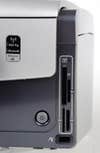
HP-Photosmart-C7180-card-readers
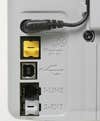
HP-Photosmart-C7180-connections.-The-HP-C7180-offe

HP-Photosmart-C7180-film-scanning-attachments

Kodak-EasyShare-5300-card-slots

Kodak-EasyShare-5300-scanning-bed
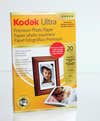
Kodak-EasyShare-5300-five-star-paper

Kodak-EasyShare-5300-control-screen

Canon-Pixma-MP810-card-slots
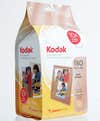
Kodak-EasyShare-5300-10-cent-bag

Kodak-EasyShare-5300

Kodak-EasyShare-5300-control-screen

Kodak-EasyShare-5300-vs-4-star-color-gamut.-Compar

Side-by-side-Image-Quality-comparisons-of-Kodak-s